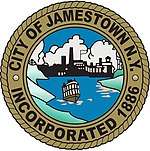Chautauqua Institution
The Chautauqua Institution (/ʃəˈtɔːkwə/ shə-TAW-kwə) is a nonprofit education center and summer resort for adults and youth located on 2,070 acres (8.4 km2) in Chautauqua, New York, 17 miles (27 km) northwest of Jamestown in the southwestern part of New York State. Established in 1874, the institution was the home and provided the impetus for the Chautauqua movement that became popular in the US in the late 19th and early 20th centuries. The Chautauqua Institution Historic District is listed on the National Register of Historic Places and was further designated a National Historic Landmark.
Chautauqua Institution Historic District | |
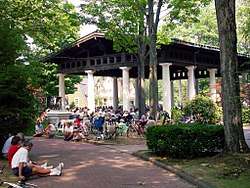 Hall of Philosophy | |
  | |
| Location | Chautauqua, NY |
|---|---|
| Nearest city | Jamestown |
| Coordinates | 42°12′35″N 79°28′01″W |
| Area | 2,070 acres (8.4 km2) |
| Built | 1874 |
| Architect | John Vincent, Lewis Miller |
| Architectural style | Late Victorian and other late 19th and early 20th-century architectural styles. |
| NRHP reference No. | 73001168 |
| Significant dates | |
| Added to NRHP | June 19, 1973[1] |
| Designated NHLD | June 29, 1989[2] |
History
Chautauqua was founded in 1874 by inventor Lewis Miller and Methodist Bishop John Heyl Vincent as a teaching camp for Sunday-school teachers. The teachers would arrive by steamboat on Chautauqua Lake, disembark at Palestine Park and begin a course of Bible study that used the Park to teach the geography of the Holy Land.[3]
The institution has operated each summer since then, gradually expanding its season length and program offerings in the arts, education, religion, and music. It offers educational activities to the public during the season, with public events including popular entertainment, theater, symphony, ballet, opera, and visual arts exhibitions.[4] The institution also offers a variety of recreational activities, plus a community education program called Special Studies along with residential programs of intensive study provided for students aiming for professional careers who audition for admittance into Chautauqua's Schools of Performing and Visual Arts.
The physical setting of the institution defined its development as an assembly. The grounds are on the west shoreline of upper Chautauqua Lake.[5] The early tent-camp assembly gave way to cottages and rooming houses, and then hotels, inns and eventually condominiums.
Founder Lewis Miller's daughter, Mina Miller Edison (wife of inventor Thomas Edison) offered literary classes in Fort Myers, Florida, through the Valinda Society. After completing courses, students were given Chautauqua diplomas.[6]
In 1973, the National Park Service added the Institution to the National Register of Historic Places. In 1989, the Department of the Interior designated it a National Historic Landmark District consisting of most of the Institution property between NY 394, formerly NY 17J, the lake and (roughly) Lowell and North Avenues.[2][7]
Institution programs
Every summer during its nine-week season, Chautauqua Institution provides an interesting array of programs including fine and performing arts, lectures, worship services, and religious programs, as well as recreational activities. Nearly 100,000 visitors come to Chautauqua to participate in these programs and events annually. Summer admission to Chautauqua is by "gate ticket," which allows entrance into the grounds, use of Smith Memorial Library, use of public beaches and parks, and attendance at lectures and concerts. There is an additional charge for some courses, for films shown at the Chautauqua Cinema, for opera and theater tickets, and use of the tennis courts and golf courses. Cottages and rooms are available for long or short term rental.[8]
Weekly programs
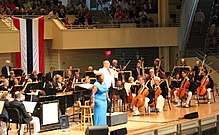
Programs offered during the week at Chautauqua include devotional services and a lecture on a social, political, or academic issue in the morning, a religious or political topic in the afternoon, and a night of entertainment as the evening program. This evening Amphitheater event may be a symphony concert by the Chautauqua Symphony Orchestra, a dance program by the Chautauqua Ballet Company, or a show by an individual guest artist. During most weeks, there is at least one opportunity to catch an opera and a play. Both put on by Chautauqua's resident summer companies. Operas are performed in English at Norton Hall, a 1930s-era, art-deco structure. There are also regularly scheduled organ recitals on the Massey Memorial Organ, student recitals, masterclasses, forums, and seminars for the sophisticated.
A broad range of special courses in music, art, dance, drama, and general topics are available. The Chautauqua Schools of Music offers extremely competitive programs with scholarships. George Gershwin visited Chautauqua as a summer refuge to compose parts of his Concerto in F in a small, wooden piano studio.[9]
Sundays at Chautauqua feature worship services, both denominational and ecumenical. There is an afternoon Amphitheater program, such as a military band or student dance program. On Sundays, entrance to the Institution grounds is free.
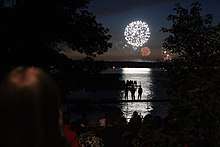
Special events
There is an annual program held on the first Tuesday of each August called "Old First Night." The event is the "birthday party" for the institution, marking the anniversary of the opening of the first season in 1874.[10] Several of the Chautauqua facilities will host fundraisers, including the Old First Night Run, a fun run around the grounds, hosted by the Chautauqua Sports Club,[11] a lip-sync contest called Air Band hosted by the Chautauqua Boys' and Girls' Club, and a bake sale hosted by the Chautauqua Children's Club. All money raised goes to the Chautauqua Fund.
Another Chautauqua favorite is the Fourth of July show at the Amphitheater specializing in patriotic-themed music followed by area fireworks viewed from the Chautauqua Lake. Occasional town barbecues at the town square (called Bestor Plaza) and weekly sailboat races are part of the overall unique Chautauqua experience.
Children's programs
The Children's School, established in 1921, is a developmental preschool for youth ages 3–5 and was a pioneering program in the field of nursery-school education. The program consists of social, recreational, and educational activities that often incorporate other Chautauqua programs in the areas of music, drama, art, and recreation.
The Chautauqua Boys and Girls Club is one of the oldest day camps in the United States, founded in 1893.[12] While parents are engaging in various activities around the grounds, their children meet in a special area by the lake and participate in sports, art, and recreational games, such as volleyball, sailing, swimming, field games, and pottery.[13]
Institution facilities
The institution's grounds, located between New York State Route 394 and Chautauqua Lake, include public buildings, administrative offices, a library, movie theater, bookstore, hotel, condominiums, inns, rooming houses, and many private cottages available for rent during the season. There are about 400 year-round residents, but the population can increase up to 7,500 guests per day during the summer season.[14] The Institution is mostly a pedestrian community with bikes and scooters widely used along with a 12-mph speed limit for cars when authorized to be on the grounds. There are several parking lots located on the periphery that visitors utilize and then walk or bike into the institution.
- The 4,000-seat Amphitheater was demolished in September 2016 to make way for a new theater-style structure, paying homage to the old structure. The new 4,500-seat Amphitheater, completed during the 2016–17 off-season, in time for the institution's 2017 season, features modern amenities and facilities and improved accessibility. This project caused some controversy due to historic nature of the old facility.[15]
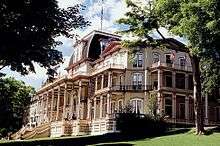
- The Athenaeum Hotel located on the grounds is the only hotel owned and operated by the institution. The 156-room hotel, said to be the largest wooden building in the eastern United States, was built in the Second Empire style in 1881. It has a two-story porch supported by narrow columns, with a central, mansard-covered tower.[16] Although the number of hotel rooms has steadily declined on the grounds in the past thirty years, there has been a corresponding growth in condominiums.
- Palestine Park is a walk-around, landscaped, geographically scaled map of Palestine showing the general contour of the area, including mountains, valleys, bodies of water and the cities in their correct geographical locations, that existed in the first century CE. Throughout the week, there are multiple tours to discuss the historical and religious significance of this world-famous area.
- The Elizabeth S. Lenna Hall is 8,000 square foot recital and rehearsal hall, dedicated in 1993. This facility was the first significant program facility to be built at the Chautauqua Institution in 65 years. The building serves as the rehearsal facility for the Chautauqua Symphony Orchestra and Music School Festival Orchestra and as a recital hall for chamber music, voice and piano.[17]
- The Lewis Miller Cottage was built in 1874 as the residence of Lewis Miller, founder and leader of the Chautauqua movement. It was named a National Historic Landmark in 1965 for its association with Miller.[18]
The Chautauqua Prize
The Chautauqua Prize is an annual American literary award established by the Chautauqua Institution in 2012.[19] The winner receives US$7,500 and all travel and expenses for a one-week summer residency at Chautauqua.[19] It is a "national prize that celebrates a book of fiction or literary/narrative nonfiction that provides a richly rewarding reading experience and honors the author for a significant contribution to the literary arts."[20]
Chautauqua Declaration
The Chautauqua Declaration is an annual declaration made at the Chautauqua Institution supporting international efforts to bring human rights violators to justice. The first declaration occurred following a meeting of current and former international chief prosecutors of international criminal tribunals and special courts in 2007. The declaration marked the 100th anniversary of the Hague Convention of 1907 and included prosecutors from the Nuremberg trials through to the International Criminal Court.[21][22] In August 2017, the Tenth Chautauqua Declaration was made, signed by prosecutors from the International Criminal Court, International Criminal Tribunal for the former Yugoslavia, Special Tribunal for Lebanon, Special Court for Sierra Leone and the Khmer Rouge Tribunal.[23]
The Chautauqua movement
In the late 19th century, following the model of the Chautauqua Institution, the Chautauqua movement spread throughout the United States and was highly popular until the start of World War II. By the mid-1920s, when circuit Chautauquas were at their peak, they appeared in over 10,000 communities to audiences of more than 45 million. The movement combined several concepts prevalent in the post-civil war US, including:
- The Lyceum movement which attempted to raise the level of public education with lectures, readings, and entertainment with goals of life long learning and self-improvement.
- Camp meetings and revivals which used outdoor gatherings
- Sunday School for the purpose of religious education.[24]
The ideals of the Chautauqua Institution spread throughout the United States through many Independent Chautauqua assemblies. Popping up were a series of traveling Chautauqua meetings, which incorporated many of the program's components, including lectures, music, nondenominational religious studies, and a focus on current issues. Several Independent Chautauquas have survived into the 21st century.
The Chautauqua Literary and Scientific Circle (CLSC), founded in 1878 by Vincent, is one of America's oldest continuously operating book clubs.[25] It was founded to promote self-learning and study, particularly among those unable to attend higher institutions of learning. Six to nine books are added to the reading list each year, with authors generally coming to Chautauqua to discuss their writing and to talk with readers.
Famous visitors
The Chautauqua Institution has been visited by political figures, celebrities, artists, musicians, scientists, and many others.
Since its founding in 1874, the Institution has been visited by four sitting United States presidents including Ulysses S. Grant (1875), Theodore Roosevelt (1905), Franklin Delano Roosevelt (1936), and Bill Clinton (1996).[26] It was at the Chautauqua Institution Amphitheater that Franklin Delano Roosevelt addressed a crowd of more than 12,000 with his historic “I hate war” speech in 1936.[27] Future President Garfield visited in 1880 and future President McKinley visited Chautquaua Institution when he was the governor of Ohio in 1895.[28]
The Institution has been visited by other historically notable figures including Booker T. Washington, Susan B. Anthony, Amelia Earhart, Thurgood Marshall and Eric Foner. Celebrities from the performing arts who performed at Chautauqua include John Philip Sousa, Duke Ellington, Ella Fitzgerald and contemporary artists such as Rhiannon Giddens, Leann Rimes, Jimmie Johnson, Toby Keith, and Clay Aiken.[29]
References
- "New York - Chautauqua County". National Register Register listings for Chautauqua County. American Dreams, Inc. Retrieved July 1, 2017.
- "Chautauqua Historic District". National Historic Landmarks Program. National Park Service. Archived from the original on September 8, 2009. Retrieved July 1, 2017.
- Feinman, Peter (May 2010). "Chautauqua America". The American Interest. Vol. 5 no. 5. pp. 83–88.
- "Niagara Falls and Western New York Sights: The Chautauqua Institution". Fodor's Travel. Internet Brands, Inc. Retrieved July 1, 2017.
- Pines, Deb (2013). In The Shadow of Death: A Chautauqua Murder Mystery. CreateSpace Independent Publishing Platform (May 31, 2013). ISBN 978-1490357614.
- Smoot, Tom (2004). The Edisons of Fort Myers. Sarasota, FL: Pineapple Press. p. 242. ISBN 9781561643127.
- Pitts, Carolyn (February 14, 1989). "National Register of Historic Places Registration: Chautauqua Institution Historic District / Chautauqa Assembly (before 1902)" (PDF). National Park Service. Retrieved July 1, 2017, Cite journal requires
|journal=(help) and Accompanying 17 photos from 1980 (5.76 MB) - "Chautauqua Institution Mission". Retrieved 25 June 2020.
- Pollack, Howard (2007). George Gershwin: His Life And Work. University of California Press. p. 346. ISBN 978-0520248649.
- "Town of Busti History: Chautauqua Lake". Town of Busti. Archived from the original on July 30, 2001. Retrieved July 1, 2017.
- Geroski, Devlin (August 6, 2013). "Old First Night: 139 years and counting..." The Chautauquan Daily. Wordpress. Retrieved July 1, 2017.
- Ruhmkorff, Piper (May 16, 2011). "Chautauqua Boys and Girls Club". Prezi. Retrieved July 1, 2017.
- "Boys' and Girls' Club". chq.org. Chautauqua Institution. Retrieved July 1, 2017.
- Glaser, Susan (June 25, 2011). "Chautauqua Institution events planned for this summer". Cleveland.com. Advance Ohio. Retrieved July 1, 2017.
- Epstein, Jonathan (September 16, 2016). "Historic Chautauqua Institution amphitheater demolished into pile of rubble". The Buffalo News. Retrieved October 16, 2016.
- "Athenaeum Hotel, Chautauqua Institution". Historic New York: Architectural Journeys in the Empire State. Landmark Society of New York. Archived from the original on May 9, 2008. Retrieved July 1, 2017.
- "The Elizabeth Lenna Hall". The Buffalo News. November 18, 1995. Retrieved August 28, 2019.
- Bradford, S. Sydney (January 7, 1975). "National Register of Historic Places Inventory-Nomination: Lewis Miller Cottage" (pdf). National Park Service. Cite journal requires
|journal=(help) - "The Sojourn Wins Inaugural Chautauqua Prize". The Post-Journal. April 29, 2012. Archived from the original on May 12, 2012. Retrieved July 1, 2017.
- "Chautauqua Prize Winners & Shortlists". chq.org. Chautauqua Institution. Retrieved July 1, 2017.
- "Chautauqua Declaration" (PDF). American Society of International Law. Retrieved 3 June 2020.
- Anderson, Elizabeth (Jun 4, 2007). "Introductory Note". International Legal Materials. 46: 974. Retrieved Jun 4, 2020.
- "Tenth Annual Chautauqua Declaration" (PDF). Retrieved June 3, 2020.
- Schmitz, Jonathan David (2011). Flanders, William. (ed.). Chautauqua Institution. Charleston, S.C.: Arcadia Pub. ISBN 978-0-7385-7512-4. OCLC 701015985.
- "CLSC Book Club". ciweb.org. Chautauqua Institution. Archived from the original on May 17, 2012. Retrieved July 1, 2017.
- Geary, David (June 30, 2016). "Four Presidents, One Chautauqua". The Chautauquan Daily. Retrieved July 1, 2017.
- "I Hate War Address". ibiblio. University of North Carolina at Chapel Hill. Retrieved July 1, 2017.
- "President Roosevelt to Make His Fourth Speech Here". The Chautauqua Daily Newspaper (Vol LX No 33). August 11, 1936. pp. 1 and 4. Retrieved 24 June 2020.
- "Overview: Chautauqua Archives".
External links
| Wikimedia Commons has media related to Chautauqua Institution Historic District. |
